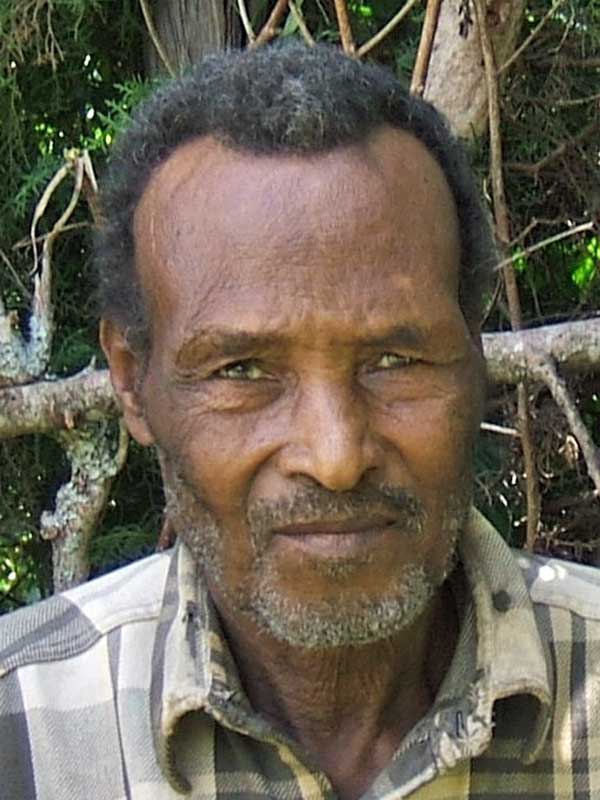Life and ministry
Erjabo Handiso was born from a Hadiyya mother and a Kambaata father in Dinika (close to the border between the Hadiyya and Kambaata areas) and passed away in 2008.
From Grenstedt (2000), Ambaricho and Shonkolla:
- Erjabo Handiso signed the KEC Constitution / “Church Rule” in AD 1952
- He taught at Mishgida Bible-school since 1962 [There was an influential Kale Heywet Choir in Mishgida]
- Since 1963, Erjabo served as Treasurer in the “Kambata Evangelical Church 2” (predecessor of the Mekane Yesus South Central Synod, as opposed to the mainline Kambata Evangelical Church which joined the Kale Heywet Church)
- President of the “Kambata Evangelical Church 2” since 1967
- From 1969 to 1973, Erjabo acted as the first President of the Mekane Yesus “Kambata Synod” (later renamed “South Central Synod”)
Erjabo Handiso’s parents were member of the Catholic Church in Ethiopia. Erjabo attended a nearby Catholic school and later served as a teacher in the Catholic Church. According to his testimony, he worked with the priests (esp. “Abba Gabure” [i.e., Abba Gabriel Kasotto]) and leaders of the Catholic Church in Wassara
- “to remove the traditional belief [a hybrid of Fandaanano and Ethiopian Orthodox Christianity] and to teach the people that the Savior is Jesus Christ.”
According to his testimony, Erjabo “learned the Gospel” from David Stokes (Bible Churchmen’s Missionary Society) in 1946 (1938 A.M.).
Although he later joined the (Baptist-oriented) Kambata Evangelical Church, Erjabo refused to be baptized a second time. The regional KHC leader Abba Gole Nunamo consented (unlike the other leaders, Sabiro Wesero and Shigute Dada).
Ato Erjabo Handiso and SIM missionary Melvin Donald translated and produced Hadiyyisa audio tracts in Bobicho (a suburb of Hossana) in 1954-55 (* English “Word of Life” scripts from Gospel Recording).
Erjabo felt that Sabiro Wesero could sing better than he and Shigute could. Erjabo and some missionaries (including Mr. Davies ??) wrote the lyrics, whereas Sabiro and Shigute sang / presented the songs to the believers.
Another person who frequently provided songs to the SIM missionaries was a brother of Abba Gole, Bekele Nunamo. The second wife of Shigute, Bashuto, was an outstanding evangelist and used to start hymns in church.
In translating the Kambata “Words of Life” scripts, Mr. Dolle Awono helped Erjabo Handiso (His proficiency in Hadiyya is better than in the Kambaata language).
In 1962 (1954 A.M.), Erjabo joined the “Kambata Evangelical Church 2”
After his presidency (1969-73), Erjabo served in the Synod’s Development and Social Services Commission (DASSC).
Erjabo Handiso promoted cooperation between Protestant denominations and was a strong advocate for literacy.
- One of the five items on the new Synod’s budget list for AD 1970 was “literacy work” (Grenstedt, p. 209. The ECMY “Yemissrach Dimts Literacy Campaign” had been started in AD 1962 [Grenstedt, p. 177; et al.]).
Audio (GlobalRecordings)
» Listen to Hadiyya Words of Life, vol. 1 (about 5 songs), © 1959
» Listen to Hadiyya Words of Life, vol. 2 (about 3 songs), © 1959
» Listen to Kambaata Words of Life, vol. 1 (about 1 songs), © 1959
» Listen to Kambaata Words of Life, vol. 2 (about 2 songs), © 1959
Picture

Further Reading
Grenstedt, Staffan. Ambaricho and Shonkolla: From Local Independent Church to the Evangelical Mainstream in Ethiopia; The Origins of the Mekane Yesus Church in Kambata Hadiya (Studia Missionalia Svecana, 82). Uppsala: Swedish Institute of Missionary Research, 2000.
» Read digital version (Diva Portal)
Ritter, Stefan. „Talking Tracts“: Beobachtungen zur Theologie und Komposition der hadiyyasprachigen Kassetten Words of Life I & II. Senior paper presented to ELM, Hermannsburg, 2004. [View online]
Rønne, Finn Aa. Kontinuitet og forandring: Opkomsten og udviklingen af protestantisk kristendom i Kambaataa-Hadiyya, Etiopien – 1928 til 1974. Copenhagen: Akademisk Forlag, 2002. [See index on p. 523]